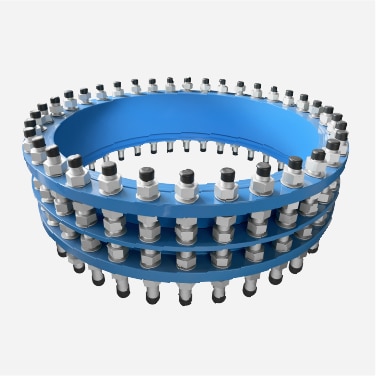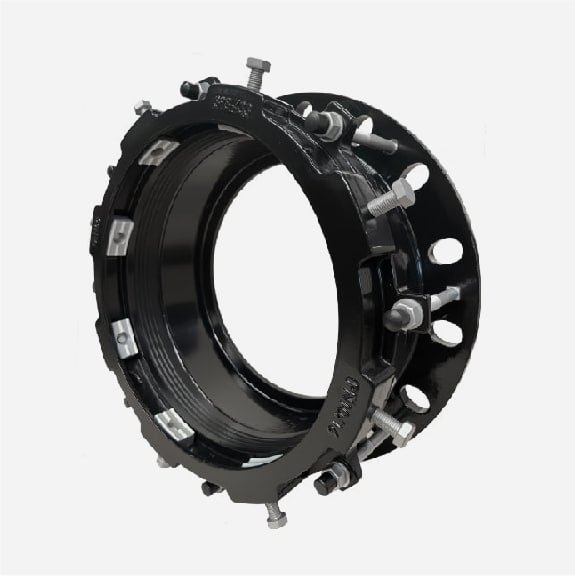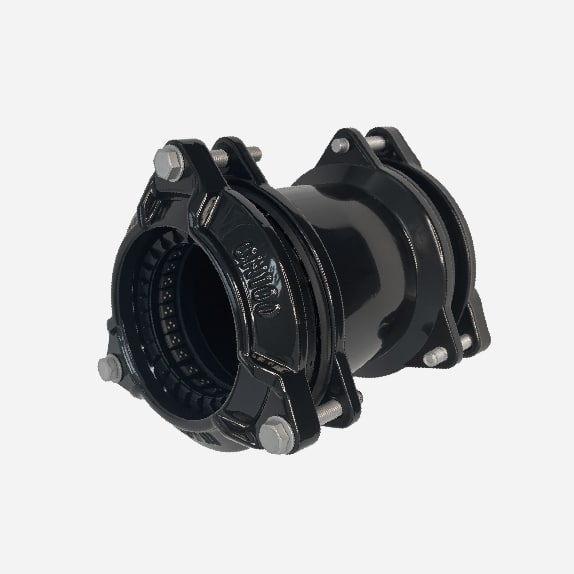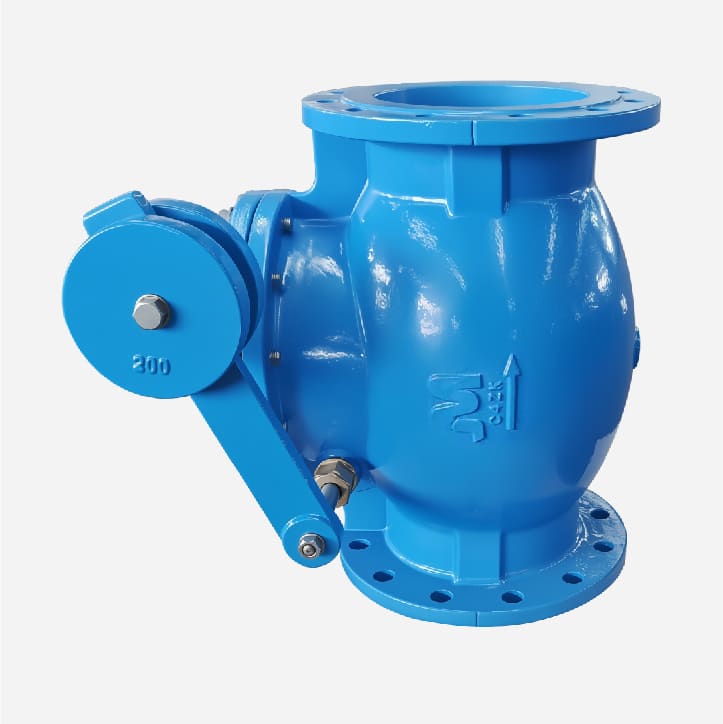Flap valve is a type of one-way valve that uses a hinged flap (or disc) to allow fluid flow in one direction and prevent backflow in the opposite direction. The valve opens when fluid pushes the flap in the direction of flow and closes when the fluid stops or reverses, creating a seal to prevent backflow.
Judberd is a professional flap valve manufacturers in China, our flap valves is as below

JUDBERD FLAP VALVE FEATURES

Lifting ring design for easy lifting of the valve cover
The detachable screen is designed to filter out debris in addition to the basic flap valve function ,also prevent snakes and rats outside the pipe from entering the pipe and causing damage to the pipeline components,
It can be easily removed if the screen is not needed.
Valve pins and clips are made of stainless steel to avoid rusting and sticking to the valve body and bonnet, and we have added large round stainless steel gasket to increase the force area of the clip, preventing damage to the clip and extending the service life of the valve.
A resilient seat is used to improve sealing performance and metal seat is also available upon request.
The flap valve body and bonnet are made of ductile iron, which is stronger and has a longer service life than other material flap valves. The surface is FBE coating to prevent rusting.
FLAP VALVE PRICE
Judberd professional R&D team can design perfect flap valve according to your requirement and working condition.
As professional manufacturer , we also offer very competitive price.If you have any enquiry, please contact judberd as below.
DIFFERENT TYPES OF FLAP VALVES AND THEIR APPLICATIONS
SINGLE FLAP VALVE
One hinged flap that opens and closes based on the flow direction.The flap opens when fluid flows in the correct direction, and closes to prevent backflow when the flow reverses. Commonly used in smaller pipelines or systems where space is limited.
DOUBLE FLAP VALVE
Has two flaps that work together to open and close.Both flaps open when fluid flows in the correct direction, and close to block reverse flow.Used in larger pipelines or where higher flow rates need to be controlled.
INCLINED FLAP VALVE
The flap is installed at an angle, allowing for more efficient fluid flow.Similar to the single or double flap valve, but with an inclined angle for better performance.Ideal for applications with varying flow conditions or where installation space is restricted.
Flap valves are available in various materials such as cast iron, stainless steel, and PVC, depending on the fluid type and environmental conditions.
They also come in a range of sizes to fit different pipeline diameters.
Each type of flap valve is chosen based on specific needs, such as the flow rate, size, material compatibility, and installation location
MATERIALS USED FOR FLAP VALVES AND THEIR SUITABILITY
The materials used in flap valves are crucial for their performance and durability in different working environments.
Below is a description of the common materials used for flap valves and their suitability for various conditions such as corrosive environments and high-pressure systems:
DUCTILE IRON (SG IRON)
_
● Durability
Ductile iron is commonly used for flap valves due to its high strength, toughness, and excellent resistance to wear and corrosion. It also provides good casting properties and can withstand higher pressure conditions compared to standard cast iron.
● Applications
Ductile iron is ideal for applications in both water and wastewater systems, and it performs well in environments with moderate corrosive conditions.
● Performance
In mildly corrosive environments, ductile iron can last for many years. However, it may require additional protective coatings or linings (such as epoxy coatings) when exposed to more aggressive media, like seawater or chemicals.
STAINLESS STEEL
_
● Durability
Stainless steel, particularly grades like SS304 and SS316, is highly resistant to corrosion, especially in harsh environments where there is exposure to chemicals, saltwater, or high moisture conditions. SS316 offers stronger corrosion resistance than SS304 and is more suitable for marine environments or areas with high chloride content.
● Applications
Stainless steel is widely used in flap valves for chemical processing, marine applications, and areas exposed to seawater, brine, or other corrosive fluids.
● Performance
Stainless steel valves perform excellently in environments with high corrosion risks, such as coastal or offshore installations. However, it may be more expensive compared to other materials.
RUBBER
_
● Durability
Rubber materials, often used for seals and flaps in flap valves, offer excellent flexibility and corrosion resistance. The most commonly used rubbers are EPDM (Ethylene Propylene Diene Monomer) and NBR (Nitrile Butadiene Rubber), each chosen based on the medium being handled.
EPDM: Ideal for use in water and wastewater systems. EPDM has great resistance to weathering, ozone, and aging, making it suitable for outdoor or UV-exposed environments.
NBR: Best suited for oil and petroleum-based fluids due to its resistance to hydrocarbons and oil.
● Applications
Rubber flaps and seals are often used in valves for less aggressive environments. Rubber components are particularly used in water treatment plants, irrigation systems, and oil transport pipelines.
● Performance
While rubber is durable in moderate conditions, it can degrade over time with exposure to UV rays, high temperatures, or aggressive chemicals. Regular maintenance and replacements may be needed to ensure continued performance.
Plastic (PVC, HDPE, etc.)
_
● Durability
Plastic materials such as PVC (Polyvinyl Chloride) and HDPE (High-Density Polyethylene) are used in flap valves for lightweight applications and environments where corrosion resistance is critical. These materials are resistant to many chemicals and are commonly used in low-pressure systems.
● Applications
Plastic flap valves are typically used in non-metallic pipelines, chemical plants, and water treatment systems where there is no risk of high pressure or extreme temperatures.
● Performance
Plastics offer excellent resistance to corrosion and chemicals, but they are not ideal for high-pressure applications. They may also have limitations in temperature tolerance and mechanical strength compared to metal-based materials.
Cast Iron
_
● Durability
Traditional cast iron is a cost-effective material for flap valves. It offers good strength and wear resistance but is susceptible to corrosion, especially in wet or aggressive environments.
● Applications
Cast iron flap valves are typically used in less demanding applications, such as in wastewater or low-pressure water systems.
● Performance
Cast iron is prone to rust and corrosion over time, especially when exposed to water, air, and aggressive chemicals. To mitigate this, cast iron valves may be coated with epoxy or other anti-corrosion treatments.
PERFORMANCE IN DIFFERENT WORKING ENVIRONMENTS
CORROSIVE ENVIRONMENTS
_
Stainless Steel (SS316) and Ductile Iron with protective coatings are the best choices for highly corrosive environments, such as marine, offshore, and chemical applications.
Rubber (EPDM or NBR) is commonly used for sealing in these environments, but the flap itself may require a more robust material such as ductile iron or stainless steel.
HIGH-PRESSURE SYSTEMS
_
Stainless Steel and Ductile Iron are the most suitable materials for high-pressure systems because of their strength and ability to withstand higher stress.
Rubber and Plastic materials are not typically used for high-pressure applications unless reinforced, as they do not offer the same strength and durability under pressure as metals.
HIGH-TEMPERATURE APPLICATIONS
_
For high-temperature environments, Stainless Steel (particularly SS316) is the best material, as it can handle heat without degrading or losing strength.
Rubber materials may degrade at higher temperatures, so it is important to choose the correct rubber material (e.g., NBR for oil and fuel, EPDM for hot water) depending on the specific conditions.
The material you choose for a flap valve should be selected based on the specific operating conditions, including the type of fluid, pressure, temperature, and environmental factors (such as exposure to chemicals, saltwater, or UV).Stainless steel and ductile iron are the best options for heavy-duty, high-pressure, and corrosive environments.Rubber and plastic are best for less demanding applications, such as low-pressure or non-corrosive systems.Choosing the right material ensures that the flap valve will perform efficiently and last longer, minimizing maintenance and repair costs.
OPERATION

The flap valve opens when the pressure inside the pipe is high enough and closes when the pressure inside the pipe is released.
No external intervention is required.
Our flap valves have an inclination of 10 degrees between the flap and the valve seat, thus ensuring that the flap valve sealed very well.
INSTALLATION
Here is a detailed guide on how to correctly install a flap valve,
including installation position, direction (vertical or horizontal), and connection methods:
PREPARATION BEFORE INSTALLATION
CHECK VALVE SPECIFICATIONS
_
Ensure the flap valve is the correct size and material for your pipeline system.
VERIFY PIPE ALIGNMENT
_
Before installing, make sure the pipeline is aligned properly and free of any debris or obstructions that could affect the valve’s operation.
INSTALLATION POSITION
VERTICAL INSTALLATION
_
Flap valves are often installed vertically, especially in drainage systems or vertical risers. This ensures the flap valve can effectively open and close based on fluid flow.
INSTALLATION STEPS FOR VERTICAL POSITION
_
Position the valve at the designated vertical pipe section.
Ensure that the flow direction aligns with the flap’s opening direction.
Make sure there is enough clearance around the valve for proper movement of the flap.
HORIZONTAL INSTALLATION
_
If the valve is being installed horizontally (common in some pipeline applications), ensure that the flap can open freely without obstruction.
INSTALLATION STEPS FOR HORIZONTAL POSITION
_
Position the valve at the designated horizontal pipe section.
Ensure the valve’s hinge axis is parallel to the ground to allow the flap to operate smoothly.
Check that there is no resistance to the flap’s opening or closing.
VALVE ORIENTATION AND FLOW DIRECTION
FLOW DIRECTION
_
The flap valve must be installed in the direction of the pipeline’s normal fluid flow. The valve’s flap will open when fluid flows in the correct direction and close when the flow reverses to prevent backflow.
MARKING FLOW DIRECTION
_
Most flap valves have an arrow on the body to indicate the correct flow direction. Ensure the arrow is pointing in the direction the fluid should flow.
PIPE CONNECTION METHODS
FLANGED CONNECTIONS
_
If the flap valve uses flanged connections, align the valve’s flanges with the flanges on the pipe.
STEPS FOR FLANGED CONNECTIONS
_
Place a gasket between the valve flange and the pipeline flange to ensure a tight seal.
Align bolt holes on both flanges.
Tighten the bolts evenly in a crisscross pattern to avoid uneven pressure on the gasket.
THREADED CONNECTIONS
_
For flap valves with threaded connections, thread the valve onto the pipe using appropriate fittings.
STEPS FOR THREADED CONNECTIONS
_
Apply pipe sealant or PTFE tape to the threads to ensure a leak-proof connection.
Screw the valve onto the pipe until it is securely tightened.
WELDED CONNECTIONS
_
Some flap valves may need to be welded into the pipeline.
STEPS FOR WELDED CONNECTIONS
_
Align the valve with the pipe and mark the welding area.
Use the appropriate welding technique (e.g., TIG welding) to weld the valve to the pipe.
Ensure the weld is clean and smooth to avoid leaks.
CHECK VALVE ALIGNMENT
ENSURE FLAP MOVEMENT
_
After installing the valve, manually check if the flap opens and closes freely. The flap should not be obstructed or stiff.
CHECK SEALING
_
Ensure that the gasket or sealing surfaces are properly in contact with no gaps, which could lead to leaks.
TEST THE INSTALLATION
After installation, it’s essential to perform a test to ensure the valve works as expected.
TEST FOR BACKFLOW PREVENTION
_
Check if the valve closes properly when the fluid flow reverses.
CHECK FOR LEAKS
_
Inspect the connection points for any leaks or signs of improper sealing.
FINAL INSPECTION AND MAINTENANCE TIPS
Once the flap valve is installed and tested, monitor it during its operation to ensure there are no unusual noises or issues with opening and closing.
TEST FOR BACKFLOW PREVENTION
_
Although flap valves require minimal maintenance, it is still a good idea to inspect them periodically for wear and tear, especially the flap and hinge mechanism.
By following these steps, you can ensure a proper and efficient installation of a flap valve. If you’re unsure about any steps, consider consulting judberd for assistance during the installation process.
MAINTENANCE AND TROUBLESHOOTING OF FLAP VALVES
Here is a guide for maintenance and
troubleshooting of flap valves, including how to check for wear, blockage, flap damage, and
how to solve any issues that arise:
REGULAR MAINTENANCE
Regular maintenance is essential to ensure the flap valve continues to function properly. Here are the key tasks you should perform:
a. Check for Wear
_
● Flap and Hinge Inspection
Over time, the flap and hinge mechanism may experience wear due to continuous opening and closing. To check for wear:Inspect the flap for any visible signs of damage or excessive wear, such as cracks, corrosion, or surface degradation.Check the hinge for any looseness, rust, or difficulty in movement.
If the flap or hinge is worn out or damaged, replace the part as necessary.
● Check the Seal
The seal between the valve body and the flap should be intact to prevent leakage.Look for any signs of leakage or a worn-out gasket.Replace the gasket or seal if there are signs of wear or damage.
b. Check for Blockages or Debris
_
● Inspect the Valve Interior
Blockages can obstruct the proper operation of the flap valve. Over time, debris, dirt, or foreign objects can accumulate inside the valve.
Open the valve (if safe to do so) and check the interior for any debris, dirt, or blockages.
Remove any obstructions or build-up inside the valve body that may be preventing the flap from moving freely.
● Check the Seal
Debris can also collect in the pipe leading to the flap valve.
Inspect the pipe for any build-up or blockages that could affect the flow of fluid to the valve.
Clean the pipe as needed to ensure smooth operation.
c. Inspect for Corrosion
_
● External and Internal Corrosion Check
If the valve is exposed to corrosive environments, both the interior and exterior parts may suffer from corrosion.
Inspect the valve for rust, scaling, or corrosion on both the external body and the flap mechanism.
For external corrosion, apply protective coatings or rust-resistant treatments to extend the valve’s life.
If internal corrosion is found, especially near the hinge or sealing area, clean the affected parts and apply corrosion inhibitors.
d. Lubricate Moving Parts
_
● Lubricate Hinges and Moving Parts
Lubrication is necessary for smooth operation and to reduce friction between the flap and hinge.
Use a high-quality lubricant suitable for your valve’s material and environment.
Apply lubricant to the hinge mechanism and any other moving parts, ensuring that they operate smoothly without resistance.
TROUBLESHOOTING AND ISSUE RESOLUTION
If you encounter issues with the flap valve, here’s how to troubleshoot and resolve them:
a. The Flap Doesn’t Open or Close Properly
_
● Cause
The flap may be obstructed or the hinge mechanism might be stuck.
● Solution
Check for any debris or blockages that might be preventing the flap from moving.
Clear any obstructions found.
Inspect the hinge for wear or damage and lubricate or replace it if needed.
Ensure that the valve is installed correctly and that the flow direction aligns with the flap’s opening direction.
b. The Valve Leaks
_
● Cause
The seal or gasket may be worn or damaged, leading to leakage.
● Solution
Inspect the seal or gasket between the flap and valve body for any visible signs of wear or damage.
If the gasket is damaged or old, replace it with a new one of the correct material.
Check the valve’s flanges or threaded connections for leaks and tighten any loose bolts or connections.
c. The Flap is Stuck or Difficult to Move
_
● Cause
The flap or hinge may be jammed, or there may be corrosion or dirt accumulation.
● Solution
Inspect the hinge and flap for signs of wear or corrosion.
Clean the flap and hinge mechanism to remove any debris.
Apply lubricant to the hinge and ensure the flap moves freely.
If corrosion is severe, replace the damaged parts.
d. Excessive Wear on the Flap or Hinge
_
● Cause
Continuous operation, improper installation, or corrosive environments can lead to excessive wear.
● Solution
Inspect the flap and hinge for signs of excessive wear, such as deep grooves, cracks, or rust.
If the flap is severely worn or damaged, replace it with a new one.
If the hinge is worn, inspect the area for any issues and replace or lubricate as needed.
e. The Valve Fails to Prevent Backflow
_
● Cause
The flap may not be sealing properly or is not closing fully due to damage or wear.
● Solution
Inspect the flap and its seal to ensure it is closing fully and sealing tightly.
Check for any obstructions that may be preventing the flap from fully closing.
If the flap is damaged or the seal is worn, replace the components.
GENERAL TROUBLESHOOTING STEPS
Turn Off the System
_
Before troubleshooting or performing maintenance, always ensure the system is shut down, and there is no fluid pressure in the pipeline.
Follow Judberd’s Guidelines
_
Always refer to judberd’s maintenance instructions for specific troubleshooting tips and part replacements.
CONSULT JUDBERD
If you are unable to resolve the issue, or if the valve requires complex repairs, it may be necessary to consult judberd technician.
By performing regular maintenance checks and following the troubleshooting steps above, you can ensure that your flap valve continues to operate smoothly and lasts for many years.
HOW DO I REMOVE THE FLAP VALVE FILTER?
The filter can be easily removed by simply using a pair of pliers and holding the pin in the middle.
The same pliers are used to hold the pin in the middle and place it over the mounting hole to put the filter back on.
FLAP VALVE ADVANTAGE OVER TRADITIONAL GATES
The advantages of using flap valves include:
SIMPLE STRUCTURE
_
Flap valves have a straightforward design, making them easy to install and operate.
HIGH RELIABILITY
_
Their simple mechanism ensures consistent performance with minimal risk of failure.
LOW MAINTENANCE
_
Due to their durable construction and automatic operation, flap valves require very little maintenance over time.
NO EXTERNAL POWER SOURCE REQUIRED
_
Flap valves operate automatically without the need for external power, making them energy-efficient and reliable in remote locations.
AUTOMATIC OPERATION
_
The valve automatically opens and closes based on flow direction, ensuring efficient and seamless operation without manual intervention.
Overall, flap valves offer a cost-effective and dependable solution for controlling backflow and regulating fluid flow in pipelines.
IS FLAP VALVE A CHECK VALVE?
Yes, flap valve is one of check valve or non return valve.
so it is also called non return flap valve.Its function is exactly same as check valve, the only special for flap valve is that it normally is installed in the end of drainage pipe.
Not in the middle line of pipe.







